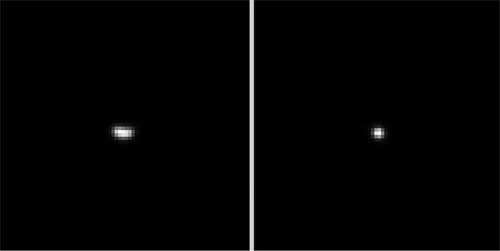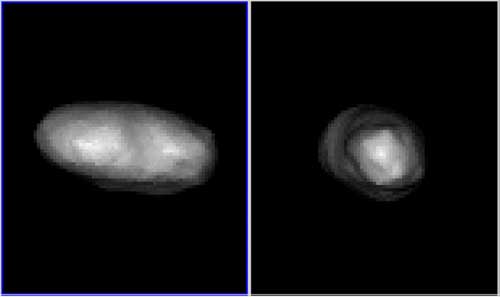Skip to comments.
Spacecraft targets asteroid
News 24 (South Africa) ^
| September 6, 2005
Posted on 09/06/2005 2:31:26 PM PDT by snowsislander
England - Rivals from the United States and Europe get the bigger headlines and bigger budgets, but a little-noticed Japanese mission to a distant space rock may scoop them all.
Launched on May 9 2003, the little probe Hayabusa ("Falcon") is now on the brink of rendezvousing with a 630-metre asteroid on a mission that could prove historic.
If all goes well, Hayabusa will be the first spacecraft to bring home raw material from an asteroid, part of the primeval rubble left over from the making of the Solar System.
"It is an utterly remarkable project which has been given almost little coverage in the media," Patrick Michel, a French astrophysicist who is involved in the mission, said on Monday.
"Understanding the chemical composition of asteroids will help us to understand how the planets were made. But the only asteroids we see on Earth are as scorched remains, as meteorites, not the raw substance itself."
Hayabusa, driven by an ion engine, a slow-but-steady form of propulsion which leaves maximum volume for scientific instruments, is now just 750 kilometres from the asteroid Itokawa, the mission website (www.jaxa.jp) of the Japanese Aerospace Exploration Agency, said on Monday.
White-knuckle part of the mission
In November comes the white-knuckle part of the mission, said Michel.
Hayabusa will gingerly manoeuvre itself to within a few metres of Itokawa and then fire a projectile weighing about five grams into the surface at a speed of 300 metres per second, or around 1 800kms an hour.
If the arithmetic is right and luck is on Hayabusa's side, material will be kicked out of the asteroid and some of it will shoot up a slender funnel.
The pellets are scheduled to be shot at three different sites in the asteroid, with each tiny sample being carefully stowed away onboard.
The spacecraft will also deploy a little robot, about the size of a large beer can, called Minerva, which for a couple of days will "hop" around the asteroid's surface, taking pictures and measuring the temperature.
Then it will be time to head for home. In June 2007, Hayabusa's precious payload, of just 100 milligrams, should land in the Australian Outback.
The United States and the European Space Agency (ESA) have deployed huge resources on media-friendly missions to analyse comets and other primitive phenomena.
They include ESA's Rosetta, a $1.2bn mission, due to climax in 2014, to deploy a robot lab on a comet and analyse its soil and transmit the data back home.
In its Deep Impact mission, the US fired a metal projectile into a comet last July, using remote sensors to analyse the gas and dust spewed out by the impact.
Another US craft, Stardust, is due to return next year with material scooped by flying through the wake of a comet.
And it sent a spacecraft, Genesis, to capture samples of the solar wind. The craft crashed into the Utah desert in September 2004, but some of its samples were saved.
TOPICS: Science
KEYWORDS: asteroid; asteroiditokawa; hayabusa; itokawa; japan
To: KevinDavis
To: snowsislander
Pictured here are the little known pilots of the tiny Japanese probe.

Some have expressed concern that returning to earth with organic matter from a comet may result in envirnmental or microbial contamination. However, the Jananses Space Agency has issued statements assuring the world that the risk of the invasion of earth by giant insects is nonexistant.
3
posted on
09/06/2005 2:44:25 PM PDT
by
frithguild
(If I made one mistake, it was that I was too cooperative and waited too long to go on the offensive.)
To: frithguild
However, the Jananses Space Agency has issued statements assuring the world that the risk of the invasion of earth by giant insects is nonexistant. Besides, the rules say they have to eat Tokyo first.
4
posted on
09/06/2005 3:08:29 PM PDT
by
Grut
To: Grut
Besides, the rules say they have to eat Tokyo first. Or maybe France?!?!

5
posted on
09/06/2005 3:17:48 PM PDT
by
frithguild
(If I made one mistake, it was that I was too cooperative and waited too long to go on the offensive.)
To: snowsislander
I found some new photographs (September 4) at ISAS from Hayabusa of Itowaka (Hayabusa is now only 500 kilometers from the asteroid Itokawa), and some extrapolations from those photographs:
 Actual Images, taken 3 hours apart
Actual Images, taken 3 hours apart
 Extrapolated Images from Above Images
Extrapolated Images from Above Images
To: frithguild
Dang, two Mothra references in one thread! And sorry, but that's "Tokyo Tower" getting noshed, just like God meant.
7
posted on
09/06/2005 4:15:15 PM PDT
by
Grut
Disclaimer:
Opinions posted on Free Republic are those of the individual
posters and do not necessarily represent the opinion of Free Republic or its
management. All materials posted herein are protected by copyright law and the
exemption for fair use of copyrighted works.
FreeRepublic.com is powered by software copyright 2000-2008 John Robinson



